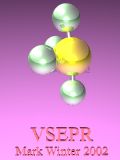 |
|---|
| VSEPR home |
|
|
| The University of Sheffield | |
| Department of Chemistry | VSEPR |
Transition metal systems
The method delineated above works very well for main group compounds but is less useful for transition metal compounds. The problem is that the lone pairs in transition metal complexes do not occupy directional orbitals in the same way as those in main group compounds. One can count electrons for transition metal compounds in exactly the same way as for main group compounds but typically the number of valence electrons will be rather larger than observed for main group metal compounds. Typical observed numbers of valence electrons vary with actual geometry. For instance, one might find anything from 12 to 22 valence electrons as the electron count in octahedral complexes. The first twelve of these are used for bonding to the six ligands. The 13th and subsequent electrons up to the 22nd, however do not, to a first approximation at least, affect the shape of the complex. They lie in atomic d orbitals which are not strongly shape-determining.
In fact, despite the larger number of electrons involved, the first order prediction of shape for transition metal complexes is simpler than for main group compounds. One can obtain very good results by simply counting ligands and placing the attached ligand groups as far apart from each other as possible. Six ligands therefore adopt an octahedral configuration, five a trigonal-bipyramidal configuration, and four a tetrahedral configuration.
There are exceptions however. There is an important group of 16-electron compounds with four attached ligands and which are d8 metals. Many of these are square-planar complexes. There is also an interesting group of complexes which are d0 ML6 species. These tend to be trigonal-prismatic rather than octahedral.
 |
|---|
|
|